| | Background | Research conclusions | Study details | Study results
Triticale is a human-made crop developed by crossing rye (Secale cereale L.) and common wheat (Triticum aestivum L.) or durum (T. turgidum L.). It is an attractive crop for use as a feed grain, cereal silage or a biofuel feedstock due to greater grain yield potential, weed competitiveness and tolerance to drought and pests, more so than its ancestral species.
Background
Spring triticale was studied for 3 years in Alberta, from 2008 to 2010, to determine the optimum dryland agronomic practices (seeding rate, seeding date and nitrogen fertilizer rate) for grain and starch productivity of the crop grown in the various agro-ecological regions of Alberta.
Research Conclusions
Triticale yield and quality benefited from early seeding in years when May temperatures were warm and accumulated Growing Degree Days (GDD) was high. However, the benefits of early seeding were minimal when May temperatures were cool or accumulated GDD was low.
Site-years with less than 130 mm of precipitation did not derive a yield benefit from seeding rates greater than 100 seeds/m2, while sites years with more than 200 mm of precipitation consistently derived a yield benefit from seeding rates greater than 100 seeds/m2.
The seeding rate at maximum yield at site-years with a significant effect of seeding rate ranged from 350 to 480 seeds/m2. Based on yield responses in this study, spring triticale in typically dry regions of Alberta should be seeded at a minimum of 200 to 250 seeds/m2 in case growing season precipitation is above average, while spring triticale in wetter areas should be seeded at a minimum of 350 seeds/m2.
The results also indicate that N fertilizer rates for triticale should be based solely on the range of expected growing season precipitation as optimum N fertilizer rate did not correlate with pre-seeding extractable soil NO3-N. Increasing rates of N fertilization increased kernel weight and protein concentration and slightly decreased starch concentration.
Study Details
Research trials were conducted at 7 locations across Alberta from 2008 through 2010 for a total of 21 site-years (Table 1). The locations ranged from Bow Island in southeastern Alberta to Falher in northwestern Alberta, encompassing the Brown soil zone, Dark Brown, Thin Black, Gray and Dark Gray soil zones. All locations were no-till, continuously cropped except Bow Island, which was summerfallowed every third year.
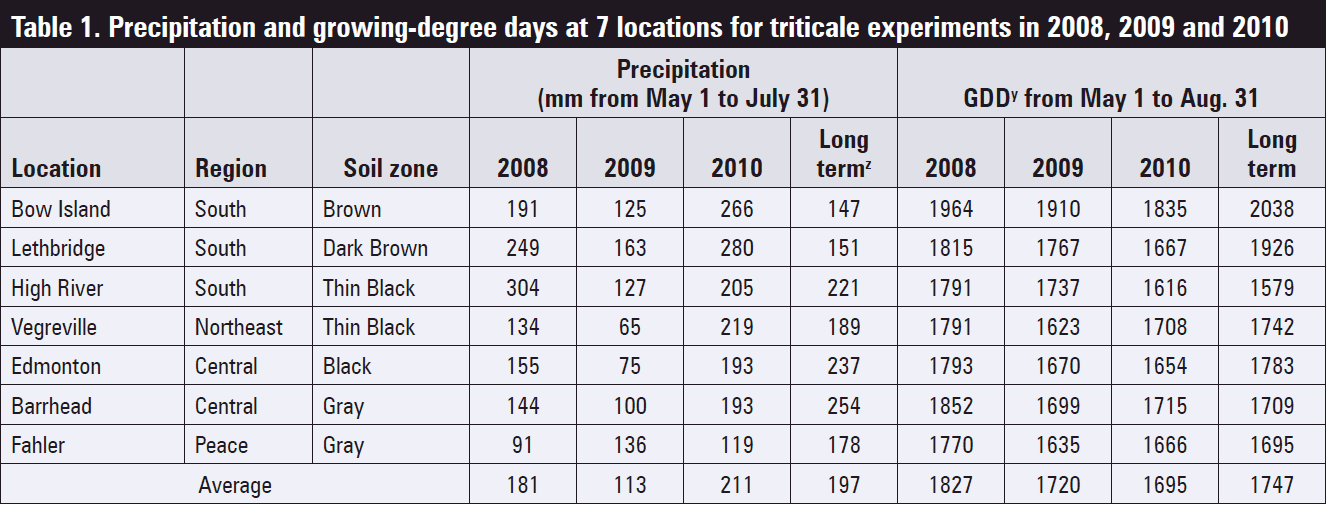
z Long-term (1971-2000) average from nearest meterological station(s).
y Growing degree days above base of 0 °C.
Two experiments were conducted at each location: 1) seeding date and rate and 2) nitrogen fertilizer.
Seeding date and rate
The effect of seeding date and seeding rate on grain and starch yield was determined for the spring triticale variety AC Ultima. Three seeding dates were included in the study, with the first seeding date usually in first week of May and the second and third dates, on average, 12 and 23 days later, but times varied due to weather conditions (Table 2). Only one seeding date was completed at High River in 2008 due to excessively wet weather. At each seeding date, triticale was seeded at 100, 200, 300, 400 and 500 viable seeds/m2.
Nitrogen fertilizer
The effect of nitrogen (N) fertilizer rate on grain and starch yield was determined for the spring triticale variety AC Ultima. Urea (46-0-0) was either side or mid-row banded at the time of seeding at rates of 0, 20, 40, 80, 120 and 160 kg N/ha (0, 18, 36, 72 and 145 lb N/ac).
The experiment was seeded at the same time as the first seeding date experiment, at a seeding rate of 250 viable seeds/m2.
Study Results
Growing conditions
Growing season precipitation (GSP) during the three years of this study was average or above average at most site-years in southern Alberta, but less than average at most site-years in other regions (Table 1). Total Growing Degree Days (GDD) over the growing season was below average at site-years in the Brown soil zone, but average or above average at most other site-years. Thus, the Brown soil zone conditions that are typically drier and warmer than other soil zones were not present during the years the study was conducted.
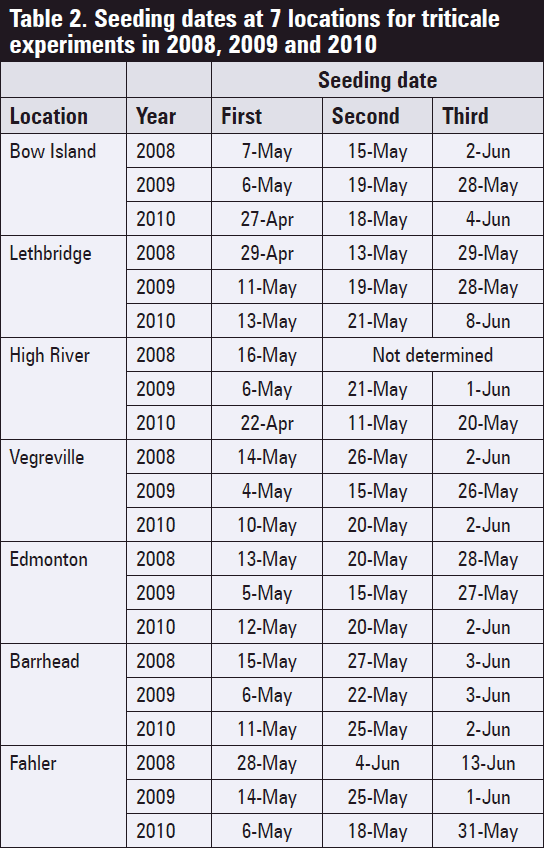
This study encompassed a wider range of growing conditions than previous studies because it was conducted for three years over a wide geographic region.
Maximum grain yields of spring triticale increased from an average of 60 bu/ac below 125 mm of growing season precipitation to an average of 100 bu/ac with more than 200 mm of growing season precipitation. However, grain yields at Bow Island were less than expected based on this relationship, particularly in 2008, the warmest site-year in this study.
Seeding rate and date
Both seeding date and rate significantly affected grain yield, kernel weight and starch yield, but not protein or starch concentration (Table 3).
At the third seeding date, average grain yield was 6 per cent less than and starch yield 8 per cent less than at the first or second seeding dates (Table 3). Relative grain yields declined by an average of only 0.1 per cent per day compared to yield declines of 0.8 per cent per day after May 1 under irrigation in southern Alberta.
The overall limited effect of delayed seeding in this study was associated with a large variation among site-years, from an increase of 25 bu/ac to a loss of 30 bu/ac. Per cent yield loss per day from each site-year was positively related to cumulative Growing Degree Days in May and June, but not with precipitation. This result indicated that yield losses due to delayed seeding increased with warmer spring temperatures.
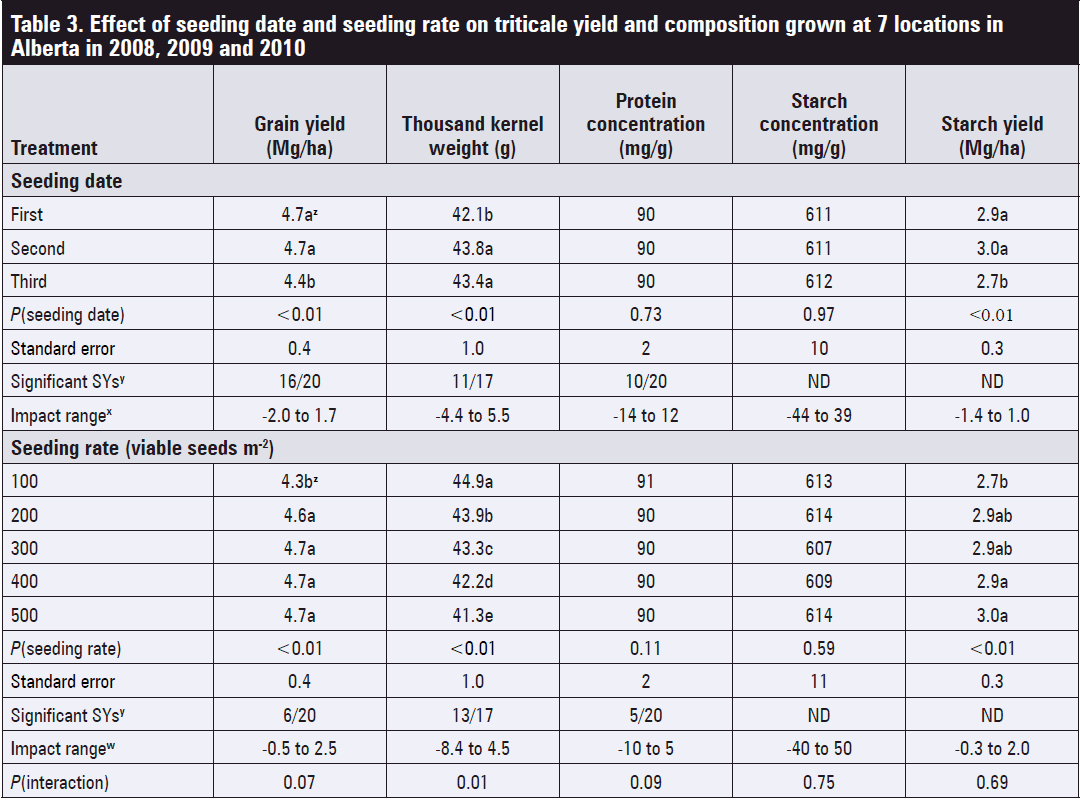
z Values followed by the same letter within a column are not significantly different (P0.05, Tukey-Kramer test).
y Number of site-years with significant seeding date or rate effect / total number of site-years measured; ND=not determined.
x The range in impact of delayed seeding among site-years. Values are the range in maximum differences between first and subsequent seeding dates.
w The range in impact of seeding rate among site-years. Values are the range in maximum differences between the lowest and all other seeding rates.
The inconsistent and modest effect of seeding date in this study was similar to that reported by other researchers, who found that a two-week delay in seeding did not consistently affect the grain yield of seven triticale cultivars in a two-year study conducted at three Alberta locations. Temperatures were generally cooler in the period covered by the study of Collier et al. (2013) and in this study than in the southern Alberta irrigated studies by McKenzie et al. (2011).
Average grain yield was 10 per cent greater at 500 seeds/m2 than at 100 seeds/m2, but based on the relationship between grain yield and seeding rate within each site-year, the maximum benefit from higher seeding rates ranged from -7 to +30 bu/ac. Site-years with less than 130 mm of precipitation did not derive a yield benefit from higher seeding rates, while site-years with more than 200 mm of precipitation consistently benefited from higher seeding rates.
Most previous studies with triticale in western Canada have been conducted at site-years with more than 250 mm of growing season precipitation and have found optimum seeding rates of 300 to 500 seeds m-2 ( see Larter et al. 1971; McKenzie et al. 2011; Collier et al. 2013 in the Reference section at the end of this factsheet). In this recent study, the seeding rate at maximum yield at site-years with a significant effect of seeding rate ranged from 350 to 480 seeds/m2. Higher seeding rates may provide benefits other than yield, such as improved weed competitive ability and earlier crop maturity. General suggested seeding rate recommendations are provided in Table 4.
Starch concentration was unaffected by seeding date or seeding rate, and thus, management practices for maximum yield productivity were also suitable for maximum starch productivity.
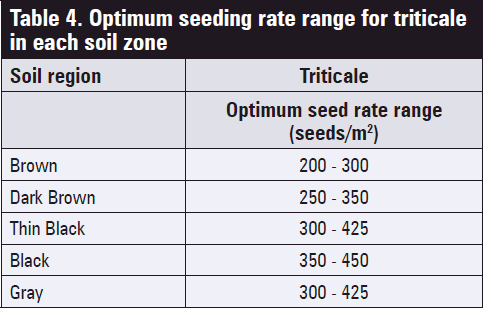
Nitrogen (N) fertilizer rate
The effect of N fertilizer rate on grain yield and the composition of triticale was highly significant when analyzed across all site-years, but the magnitude of N fertilizer benefits varied widely among site-years (Table 5).
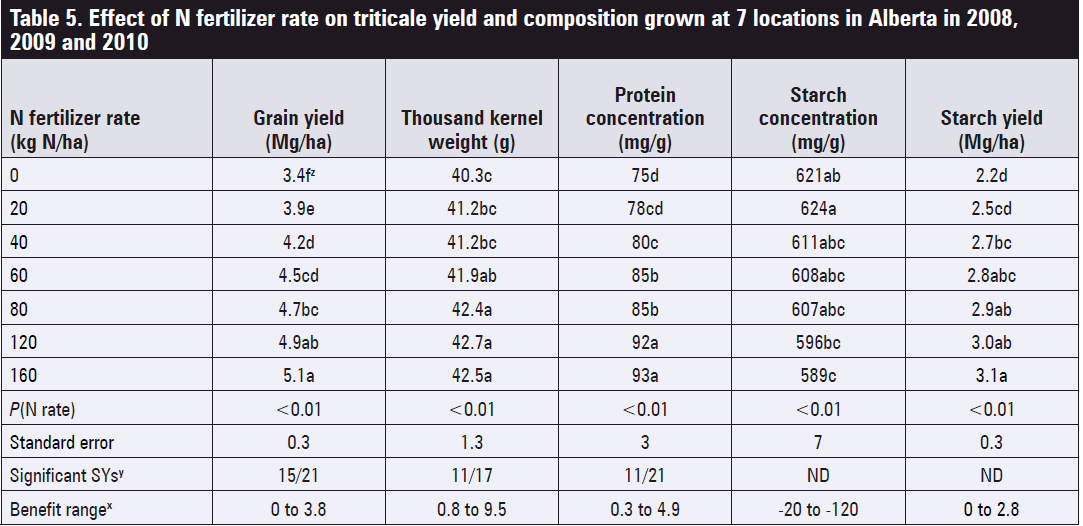
z Values followed by the same letter within a column are not significantly different (P0.05, Tukey-Kramer test).
y Number of site-years with significant N rate effect / total number of site-years measured; ND=not determined.
x The range in maximum benefit due to N fertilizer addition among site-years. The maximum benefit over the unfertilized check at each site-year was based on regression equations for grain and starch yield and on least-square means for all other variables. Maximum grain yields ranged from 27 to 125 bu/ac, while unfertilized grain yields ranged from 10 to 90 bu/ac, 16 to 100 per cent of maximum grain yields. The Economically Optimum Nitrogen Rate was 110 kg N/ha (100 lb N/ac) based on the average yield response to N fertilization, but among site-years, this rate ranged from 0 to more than 160 kg N/ha (0 to 145 lb/ac).
Pre-seeding soil test nitrate-N was not closely related to unfertilized grain N yield, which was due to appreciable and variable N mineralization at low levels of soil nitrate-N and to appreciable and variable losses. Based on the results from this study, N fertilizer rates for triticale should be based solely on the range of expected growing season precipitation for a given location and year.
Nitrogen fertilization increased both kernel weight and protein concentration, and it also decreased starch concentration. However, the decline in starch concentration was small compared to the effect on grain yield, and thus, starch yields in the unfertilized treatment ranged from 18 to 100 per cent of maximum starch yields, similar to the range obtained for grain yield.
Nitrogen fertilizer rates suitable for optimal grain production were also suitable for optimal starch production. Suggested nitrogen fertilizer recommendations are provided in Table 6.
Acknowledgements
The authors would like to acknowledge Alberta producers Terry Doran, Harley Southerland, Kevin Speers, Gordon Tuck, Jim Greilach and Greg Porozni, for kindly providing land for this study as well as the Alberta Agriculture Irrigation and Farm Water Division, Soil Lab for soil analysis. The authors gratefully acknowledge funding support for this project from the Canadian Triticale Bio-refinery Initiative.
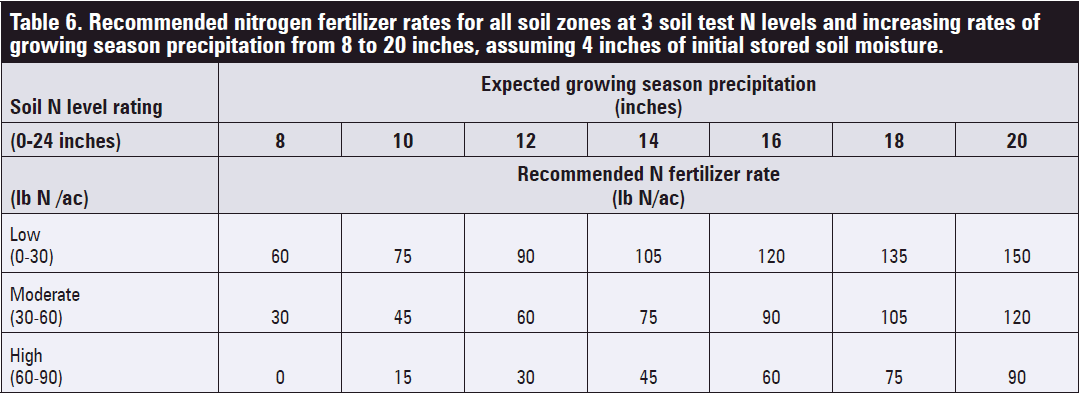
References
Collier, G. R. S., Beres, B. L., Salmon, D. F., Nyachiro, J. M., Bork, E. W. and Spaner, D. M. 2013. The effect of cultivar, seeding date and seeding rate on triticale in the western Canadian prairies. Agron. J. 105:546–554.
Larter, E. N., Kaltsikes, P. J. and McGinnis, R. C. 1971. Effect of date and rate of seeding on the performance of triticale in comparison to wheat. Crop Sci. 11:593-595.
McKenzie, R. H., Bremer, E., Middleton, A. B., Pfiffner, P. G. and Woods, S. A. 2011. Optimum seeding date and rate for irrigated cereal and oilseed crops in southern Alberta. Can. J. Plant Sci. 91:293-303.
Information prepared by
Ross H. McKenzie PhD, P. Ag.
Senior Research Scientist – Agronomy (Retired)
Alberta Agriculture and Rural Development
Doon Pauly MSc
Research Scientist – Agronomy
Crop Research and Extension Division
Alberta Agriculture and Rural Development
Lethbridge, Alberta
Telephone: 403-381-5830
More information, contact
Alberta Ag-Info Centre
Call toll free 310-FARM (3276)
Source: Agdex 118/10-1. August 2013. |
|